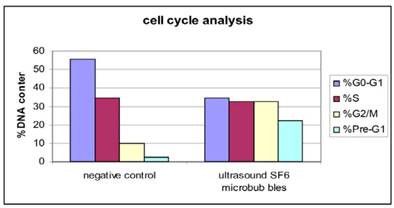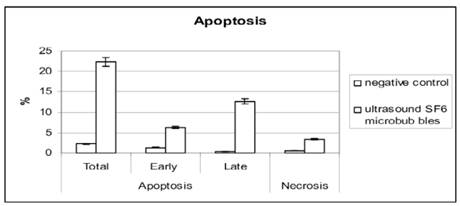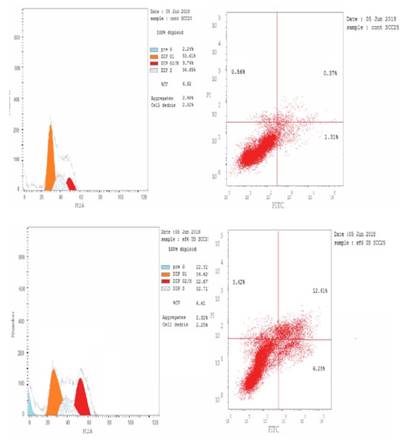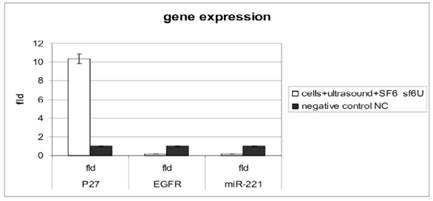Abstract
Micro-RNA-221(miR-221) is one of oncogenic miRNAs that plays a vital role in the development and progression of oral cancers. The aim of this study is to introduce a new gene therapy for oral squamous cell carcinoma by blocking the expression of oncogenic miR-221 by its inhibitor. The present work was performed on squamous cell carcinoma cell line SCC-25 and anti-miR-221 was delivered to the cells using an ultrasound micro bubbles. Assessment of the effect of miR-221 inhibitor on SCC-25 cells was done using MTT assay, cell cycle analysis and apoptosis detection. In addition, reverse transcription-polymerase chain reaction was also used to detect the expression -miR-221 and its target genes. Using ANOVA, statistical analysis of the results showed significant inhibition of cell viability with and induction of cell apoptosis of SCC-25 cell line after transfection. Moreover, the expression of miR-221, Epidermal growth factor receptor (EGFR) and CDKNIB/p27 were downregulated without significant difference. Transfection of SCC-25 by inhibitor of miR-221 resulting in blockage of its expression leading to arresting of tumor growth. These results proved the effective role of micro-RNA inhibitors as novel therapeutic agent for oral cancers.
Key Words:
oral cancer; miR-221; ultrasound micro bubble; gene therapy; cdkn1b/p27; SCC
Resumo
Micro-RNA-221 (miR-221) é um dos miRNAs oncogênicos que desempenham um papel vital no desenvolvimento e progressão de carcinomas orais. O objetivo deste estudo é apresentar uma nova terapia gênica para o carcinoma epidermóide oral por meio do bloqueio da expressão do miR-221 oncogênico por seu inibidor. O presente trabalho foi realizado na linhagem de células de carcinoma de células escamosas SCC-25 e o anti-miR-221 foi administrado às células usando micro-bolhas de ultrassom. A avaliação do efeito do inibidor miR-221 em células SCC-25 foi feita usando ensaio de MTT, análise do ciclo celular e detecção de apoptose. Além disso, a reação em cadeia da polimerase com transcrição reversa também foi usada para detectar a expressão -miR-221 e seus genes-alvo. Usando ANOVA, a análise estatística dos resultados mostrou inibição significativa da viabilidade celular e indução da apoptose celular da linhagem celular SCC-25 após a transfecção. Além disso, a expressão de miR-221, receptor do fator de crescimento epidérmico (EGFR) e CDKNIB/p27 foram regulados para baixo sem diferença significativa. A transfecção de SCC-25 por inibidor de miR-221 resultou no bloqueio de sua expressão, levando à interrupção do crescimento do tumor. Esses resultados comprovaram o papel eficaz dos inibidores de micro-RNA como novo agente terapêutico para carcinomas orais.
Introduction
Oral cancer account 3% of all cancer types in United States and about 90% of oral cancer are squamous cell carcinoma (OSCC). Survival rate of OSCC remains significantly low when compared with other cancer types and the death rate is higher than that of other cancer types such as cervical cancer, laryngeal cancer and Hodgkin lymphoma 11 . Santoro GP, Papagerakis S, Serpico R, Guida A, Lo Muzio L, Bufo P. Epigenetic profiling of oral cancer. In Oral Cancer; Ogbureke, D.K.U.E., Ed 2012; In Tech: Rijeka, Croatia,Chapter 16;pp.297-296.. Pointing to a need to new drug targets for treatment of OSCC, analytical understanding of oncogenesis and careful determination of therapeutic targets are essential.
Cancer is a complex disease resulting from genetic abnormalities that promote the expression of oncogenes and suppress tumor suppressor genes expression. Treatment of cancer with chemotherapeutic agent that target single pathway increases the susceptibility of chemoresistance. Therefore, developing new genetic therapy that regulating multiple genes achieving a cumulative effect on target proteins at multiple levels in the same pathway such as micro RNA based therapies is crucial 22 . Posner M, Vermorken JB. Induction therapy in the modern era of combined-modality therapy for locally advanced head and neck cancer. Semin Oncol 2008;35:221-228..
MicroRNAs are small single-stranded non-coding RNAs (18- 25nt) that control the gene expression by post-transcriptional binding to the 3’-untranslated region (3´-UTR) of mRNAs leading to gene silencing 33 . Acunzo M, Romano G, Wernicke D, Croce CM. MicroRNA and cancer - A brief overview. Adv. Biol 2015;57:1-9.. Accumulating evidence indicates that certain types of miRNAs were abnormally overexpressed in human cancers resulting in genetic alterations and affecting several cell-signaling pathways that leading to carcinogenesis 44 . Zhang W, Dahlberg JE, Tam W. MicroRNAs in tumorigenesis: a primer. Am J Pathol 2007;171:728-738.,55 . udhu A, Ji J, Wang XW. The clinical potential of microRNAs. J Hematol Oncol 2010;3:37..
Moreover, miRNAs can act as oncogenes or oncosuppressor genes depends on the target genes in the cellular context. The oncogenic miRNAs such as miR-221 inhibit the expression of the tumor suppressor genes. It exerts anti-apoptotic effect by targeting the tumor suppressors as phosphatase and tensin homolog (PTEN) and programmed cell death 4 (PDCD4) resulting in cancer development 66 . Meng F, Henson R, Wehbe-Janek H, Ghoshal K, Jacob ST, Patel T. MicroRNA-21 regulates expression of the PTEN tumor suppressor gene in human hepatocellular cancer. Gastroenterology 2007;133:647-658.,77 . Kota J, Chivukula RR, O'Donnell KA, Wentzel EA, Montgomery CL, Hwang HW et al. Therapeutic microRNA delivery suppresses tumorigenesis in a murine liver cancer model. Cell 2009;137:1005-1017.,88 . Majid S, Dahiya R. MicroRNAbased therapeutic strategies for cancer: Emphasis on advances in renal cell carcinoma. MicroRNA Targeted Cancer Therapy pp. 2014;175-178.,99 . Maltby S, Plank M, Ptaschinski C, Mattes J, Foster PS. MicroRNA function in mast cell biology: protocols to characterize and modulate microRNA expression. Methods Mol Biol 2015;1220:287-304.,1010. Moscato S, Ronca F, Campani D, Danti S. Poly(vinyl alcohol)/gelatin Hydrogels Cultured with HepG2 Cells as a 3D Model of Hepatocellular Carcinoma: A Morphological Study. J Funct Biomater 2015;6:16-32..
MiRNA-based gene therapy is a recent therapeutic strategy aimed to correct the bizarre expression of oncogenic miRNA. This approach resulting in inhibition of overexpressed miRNAs in cancer cells by introducing anti-miRNA oligonucleotides (AMOs) and impact its suppression effect on miRNA target genes with its complementary base pairing. Thus, leading to restoring the role of tumor suppressor genes that had been lost 1111. Tomanin R, Scarpa M. Why do we need new gene therapy viral vectors? Characteristics, limitations and future perspectives of viral vector transduction Curr Gene Ther2004;4:357-372.,1212. Dai R, Li J, Liu Y, Yan D, Chen S, Duan C, et al. miR-221/222 suppression protects against endoplasmic reticulum stress-induced apoptosis via p27(Kip1)- and MEK/ERK-mediated cell cycle regulation. Biol Chem 2010;391:791-801.,1313. Raisch J, Darfeuille-Michaud A, Nguyen HT. Role of microRNAs in the immune system, inflammation and cancer. World J Gastroenterol 2013;19:2985-2996.,1414. Hung CH, Chiu YC, Chen CH, Hu TH. MicroRNAs in hepatocellular carcinoma: carcinogenesis, progression, and therapeutic target. Biomed Res Int 2014;2014:486407..
The effective delivery method of miRNA-based therapeutics is the major challenge. Rapid degradation of naked miRNA and AMO by cellular nucleases makes their direct delivery is the unique option. In addition, micro RNAs have a negative charge and tiny size which may prevent their passage through the cell membranes. Therefore, they need several forms of targeted delivery vehicle for specific tissue. Traditionally, both viral vectors and nonviral vectors were used for genetic delivery. However, because the toxicity and immunogenicity of viral vectors and the low transfection efficiency of nonviral vectors, the application of these vectors is constrained clinically 1515. Suzuki R, Oda Y, Utoguchi N, Maruyama K. Progress in the development of ultrasound-mediated gene delivery systems utilizing nano- and microbubbles. J Control Release 2011;149:36-41. Recently, ultrasound microbubbles have been used; they are nanobubbles with many advantages when compared with traditional transfection vectors, such as higher stability, good biocompatibility and effective transfection property. Ultrasound contrast agent has been used to enhance the ultrasound image. Moreover, ultrasound microbubbles are used in non-invasive gene delivery system and have been widely utilized to examine the functions of miRNA 1515. Suzuki R, Oda Y, Utoguchi N, Maruyama K. Progress in the development of ultrasound-mediated gene delivery systems utilizing nano- and microbubbles. J Control Release 2011;149:36-41.
The inhibitory effect of anti-miR-221was reported in several types caner such as hepatocellular carcinoma 1616. Elfadl AA, Azzab NI, Elwia SK, Shabaan D. Molecular therapeutic role micro-rna 221 inhibitor in hepatocellular carcinoma. J Mol Cell Biochem 2018;2:1-6.,1717. Guo X, Guo S, Pan L, Ruan L, Gu Y, Lai J. Anti-microRNA-21/221 and microRNA-199a transfected by ultrasound microbubbles induces the apoptosis of human hepatoma HepG2 cells. Oncol Lett 2017;13:3669-3675.. In OSCC cells, to the best of our knowledge, previous researches have not examined DNA transfection using ultrasound microbubble. In the present study we examine the effects of anti-miR-221 on SCC25 cells that delivered by ultrasound micro bubble-mediated gene transfection.
Material and Methods
Cell Culture
Squamous cell carcinoma SCC-25 cell line (ATCC, USA) was used. It maintained in Dulbecco’s modified Eagle’s medium (DMEM; HyClone; GE Healthcare Life Sciences, Logan, UT, USA) and 10% fetal bovine serum (FBS; HyClone; GE Healthcare Life Sciences) was added. The cells were divided in 96-well plate and preserved in 5% CO2 atmosphere at 37 °C for 24 h.
Chemical Structure of Anti-Mir-221
Anti-miR-221 sequences (Invitrogen; Thermo Fisher Scientific, Inc., Waltham, MA, USA) were placed into BamHI and HindIII sites of the GV249 vector [a vector containing enhanced green fluorescent protein (EGFP); Shanghai Jikai Communication Technology Co., Ltd., Shanghai, China]. The recombinant plasmids were named as EGFP-anti-miR221. The sequence of primer used for cloning as follow miR-221 sense, 5’- AGC TAA AAA AGC TAC ATT GTC TGC TGG GTT TCG-3’ and antisense, 5’- GAT CCG AAA CCC AGC AGA CAA TGT AGC TTT TTT-3’.Cells were divided into 5 groups (Table 1).
Preparation of Ultrasound Micro Bubble Contrast Agent (Sulfur Hexafluoride)
Micro bubbles were prepared following the manufacturer’s protocol. For sulfur hexafluoride (SF6; Bracco Suisse SA, Manno, Switzerland), saline solution of 5 mL was introduced into a vial with freeze-dried powder. The vial was then shaked until the powder was disappeared. The mixture was used within 6 h. A 10,000 cells were divided onto a 96-well plate, contrast agents was suspended in DMEM containing 10% FBS. The culture was maintained for 48 h at 37°C ultrasound parameters used are 2.0 MHz and MI, 0.28. Prior to treatment, cells were rinsed with DMEM. 1616. Elfadl AA, Azzab NI, Elwia SK, Shabaan D. Molecular therapeutic role micro-rna 221 inhibitor in hepatocellular carcinoma. J Mol Cell Biochem 2018;2:1-6..The experiment was performed in triplicate.
Ultrasound treatment was then provided the target group for 30 sec. According to the manufacturer’s protocol Lipofectamine 2000-mediated gene transfection was done. After 48h transfection, MTT, RT-PCR, flow cytometry were done 1717. Guo X, Guo S, Pan L, Ruan L, Gu Y, Lai J. Anti-microRNA-21/221 and microRNA-199a transfected by ultrasound microbubbles induces the apoptosis of human hepatoma HepG2 cells. Oncol Lett 2017;13:3669-3675..
Detection of Cytotoxicity By MTT Method
MTT (20 μL; 5 mg/mL dissolved in PBS; Genview; Sigma-Aldrich; EMD Millipore, Billerica, MA, USA) was added to the cells and maintained for 4 h at 37 °C. The absorbance was detected on a Micro plate Spectrophotometer (BioTek Elx 800; BioTek Instruments, Inc., Winooski, VT, USA) at 490 nm.
RNA Extraction, Cdna Synthesis and RT-Qpcr
Cells transfection with the recombinant plasmid (EGFP-anti-miR221) and vector plasmid (GV249) was performed via ultrasound microbubble SF6. Then, post-transfection cells collection were performed after 48 h . Non-transfected cells were considered as a blank control. Extraction of total RNA was done using RNAeasy RNA extraction kit (Qiagen) according to the manufacturer's instructions.
The primers for miR-221, using the internal U6 control (sense, 5’- TCG CTT CGG CAG CAC A-3’ and antisense, 5’-AAC GCT TCA CGA ATT TGC GT-3’) and p27 gene expressions (p27F 5’-GTCCACCGCAAATGCTTCTA-3’, p27 R 5’TGCTGTCACCTTCACCGTTC-3’) and Epidermal growth factor receptor (EGFR) gene expression (EGFR F 5’-CCTTAGGTGCGGCTCCACAGC-3’, EGFR R 5’-CATTTAGGATGTGGAGATGAGC-3’) using b-actin as house keeping gene, primer were obtained from sigma F 5’-GTGACATCCACACCCAGAGG-3’, b-actin R 5’-ACAGGATGTCAAAACTGCCC-3’.
Using the Iscript One-Step RT-PCR Kit with SYBR®Green
The expression of miR-221, p27 and EGFR were computed with the formula 2-Δcq, and the change ratio of miR-221 in the experiments was: (1-1/2ΔΔCq) × 100%.
Flow Cytometry Analysis Using Facscalibur (BD Biosciences, Franklin Lakes, NJ, USA)
It was done at an emission wavelength of 530±15 nm and excitation wavelength of 488 nm. After transfection, cells were stained with propidiumc iodide and analysis of the cell cycle was performed on FACSCalibur. Annexin V PE/7 AAD apoptosis detection kit was used for detection of cell apoptosis.
Statistical Analysis
Results were analyzed using IBM Statistical Package for Social Sciences (SPSS), version 21 (SPSS Inc., IL, USA). Numerical data was described as mean and standard deviation and comparisons between these were performed using ANOVA and a post-hoc Tukey test. P value considered significant when it equal or less than 0.05.
Results
In the present study, we analyzed the effect of anti-miR-221 on SCC-25 cell line that was subjected to ultrasound contrast agent microbubbles. First, cell proliferation was assessed using MTT treatment, and then flow cytometry was used for detection of cell death and also for cell cycle analysis. Finally, the expression of miRNA-221, cell cycle regulatory gene P27 and EGFR were assessed using reverse transcription-polymerase chain reaction RT QPCR.
MTT Assay:
Marked decrease in the number of viable cells (39.33±0.057) in the ultrasound SF6 microbubbles group was observed with statistically significant difference when compared with negative control (p=0.000). This result indicates the effective role of anti-miRNA-221 in suppression of cell proliferation when compared to other groups (Table 2, Fig. 1).
Cytotoxicity of SCC-25 cell line after transfection with anti-miRNA-221, showing marked decrease in the number of viable cells in sf6U group when compared with other groups.
Flow Cytometry:
Cell cycle analysis by flow cytometry show that at ultrasound SF6 microbubbles(sf6U) group there is statistical significant cell death at PreG1(22.2±10) and cell growth arrest at G1 (34.56±0.057) . However, in S phase show slight change without statistical significance when compared with negative control group (Table 3, Fig. 2).
Mean distribution of cell cycle analysis demonstrating significant cell death at PreG1, cell growth arrest at G1 and non-significant change at S phase when compared with the negative control.
After transfection of SCC-25 cell line with anti-miRNA-221 cell apoptosis and necrosis were detected by flow cytometry. The anti-miRNA-transfected group showed a significant increase in apoptosis (22.23±0.11 ) when compared with negative control (p=0.0006). In addition, there is a marked increase in necrosis in ultrasound microbubbles Usf6 group (3.37±0.064) when compared with negative control group (p=0.0009). (Table 4, Figs. 3 and 4).
Apoptosis and necrosis of SCC-25 following transfection with anti-miRNA-221 revealed a significant increase (p≤0.05) when compared with the negative control.
RT-PCR:
Post transfection, miR-221 was markedly down regulated (0.1726±0.005) in association with up regulation of CDKNIB/p27 (10.276±0.068) and down regulation of EGFR (0.163±0.0060) without statistical significance when compared to negative control (Table 5, Fig. 5).
Expression of mi-RNA-221, p27 and EGFR in SCC-25 after transfection with anti-miRNA-221 showing downregulation of both mi-RNA-221 and EGFR and upregulation of p27 which means cancer cell proliferation arrest.
Discussion
MiRNAs are implicated in the pathogenesis, growth, progression and prognosis of cancers including OSCC, making them an important target for genetic therapy 33 . Acunzo M, Romano G, Wernicke D, Croce CM. MicroRNA and cancer - A brief overview. Adv. Biol 2015;57:1-9.. Overexpression of oncogenic miRNAs such as miRNA-221 on OSCC had been reported 1313. Raisch J, Darfeuille-Michaud A, Nguyen HT. Role of microRNAs in the immune system, inflammation and cancer. World J Gastroenterol 2013;19:2985-2996.. Thus, gene therapy targeting oncogenic miRNA is considered as promising candidate in the cancer treatment including OSCC. However, the big problem facing the application of gene therapy is the absence of safe and efficient vectors. In this study, we used ultrasound micro bubbles as gene delivery system which improves transfection efficiency and expression of DNA in the local cells 1616. Elfadl AA, Azzab NI, Elwia SK, Shabaan D. Molecular therapeutic role micro-rna 221 inhibitor in hepatocellular carcinoma. J Mol Cell Biochem 2018;2:1-6.,1717. Guo X, Guo S, Pan L, Ruan L, Gu Y, Lai J. Anti-microRNA-21/221 and microRNA-199a transfected by ultrasound microbubbles induces the apoptosis of human hepatoma HepG2 cells. Oncol Lett 2017;13:3669-3675..
The aim of our study was to examine the efficiency of transfection of anti-miR-221 on SCC-25 cells by using ultrasound micro bubbles and analyzed the inhibitory effect of anti-miRNA-221 on SCC-25 cells through MTT, cell cycle analysis and apoptosis assays. The expression of miRNA-221, Cyclin dependant kinase inhibitor CDKNIB/p27 and EGFR were detected by using reverse transcription polymerase chain reaction.
The loss of oncogenic effect of miRNA-221 after transfection of SCC-25 with ant-miRNA-221 was resulting from interactions between endogenous nucleic acids and anti-miRNA oligonucleotide thus miRNA inhibitior may be a promising for treatment of SCC. Thus, the level of endogenous miR-221 oligonucleotides was decreased by measuring miR-221-related gene levels. Following transfection of ant-miR-221 in SCC-25 cell lines, the cell proliferation was decreased dramatically. This indicate the direct relationship between the overexpression of miR-221 and proliferation of epithelial cells in SCC . In addition, the treatment of SCC-25 with anti-miRNA-221 resulting in induction of apoptosis of the cells which leading to another prove of oncogenic role of miR-221. These findings are consistent with previously reported research in hepatocellular carcinoma 1616. Elfadl AA, Azzab NI, Elwia SK, Shabaan D. Molecular therapeutic role micro-rna 221 inhibitor in hepatocellular carcinoma. J Mol Cell Biochem 2018;2:1-6.,1717. Guo X, Guo S, Pan L, Ruan L, Gu Y, Lai J. Anti-microRNA-21/221 and microRNA-199a transfected by ultrasound microbubbles induces the apoptosis of human hepatoma HepG2 cells. Oncol Lett 2017;13:3669-3675.,1818. Winter J, Diederichs S. MicroRNA biogenesis and cancer. Methods Mol Biol. 2011;676:3-22..
The progression of the cell cycle depends on various cyclins, cyclin dependent kinases (Cdks) and their inhibitors, which regulated by miRNAs 1919. Hatfield SD, Shcherbata HR, Fischer KA, Nakahara K, Carthew RW, Ruohola-Baker H. Stem cell division is regulated by the microRNA pathway. Nature. 2005 Jun16;435:974-978.. It had been reported that in glioblastoma cells miR-221 is directly inhibited CDKN1B/p27 2020. Visone R, Russo L, Pallante P, De Martino I, Ferraro A, Leone V, et al. MicroRNAs (miR)-221 and miR-222, both overexpressed in human thyroid papillary carcinomas, regulate p27Kip1 protein levels and cell cycle. Endocr Relat Cancer 2007;14:791-798.. Therefore, by performing flow cytometrey to analyze the cell cycle of post transfected cells the results showing that there is significant arrest of the cell growth and apoptosis at G1 phase. However, at S phase there was no significant change. In addition, it had been found that the progression of cell cycle, accompanied by overexpression of miR-221 thus affecting both CDKN1B/p27 and EGFR. Our results were coincidence with previous research in hepatocellular carcinoma 1717. Guo X, Guo S, Pan L, Ruan L, Gu Y, Lai J. Anti-microRNA-21/221 and microRNA-199a transfected by ultrasound microbubbles induces the apoptosis of human hepatoma HepG2 cells. Oncol Lett 2017;13:3669-3675..
In the present study, flow cytometery was performed to examine the effect of anti- miR-221 on apoptosis of SCC-25 cells. It had been found that there was an increase in apoptosis at early and late phases with anti-miRNA-221 transfected group with ultrasound SF6 microbubbles. Moreover, there was a increase in necrotic tissue . These results concoluded that there was significant increase in apoptosis of SCC-25 cells after transfection with anti-miRNA-221. This means that miR-221 can inhibit apoptosis, thus miR-221 act as posttranscriptional regulator of both necrosis factor related apoptosis and FAS-induced apoptosis.
The miRNA-221 is enhanced by EGFR and also regulates the downstream EGFR signaling pathway, therefore it can used as an indicator of tumor proliferation and growth 2121. Saito M, Schetter AJ, Mollerup S, Kohno T, Skaug V, Bowman ED, et al. The association of microRNA expression with prognosis and progression in early-stage, non-small cell lung adenocarcinoma: a retrospective analysis of three cohorts. Clin Cancer Res 2011;17:1875-1882.. For more confirmation of our results, we using RT-qPCR, after the transfection of the SCC-25 with anti-miRNA-221, the miR-221 expression level was found to be downregulated. In addition, the expression of EGFR was decreased and the expression of CDKNIB/p27 was increased following transfection of the cell. These findings were proved that miRNA-221 inhibitor can efficiently decrease growth of the tumor and cell proliferation and arrest the cell cycle progression.
The present data proved that the delivery of anti-miR-221 to the cells can be done via ultrasound micro bubble transfection resulting in inhibition of cell proliferation and induction of cell apoptosis. This study showed the vital role of miRNA as therapeutic target carrying a new hope for cancer therapy. In addition, it can be used to potentiate the effect of the chemotherapy as it regulate multiple genes and signaling pathway while chemotherapy target only single pathway.
Finally, while the clinical application of micro RNA based therapeutics is in its early stage, the recent introduction of novel biodelivery method of micro RNAs which is one of the main challenge together with better understanding of their functions allow a rapid progress toward clinical application of micro RNA based therapeutics.
References
-
1Santoro GP, Papagerakis S, Serpico R, Guida A, Lo Muzio L, Bufo P. Epigenetic profiling of oral cancer. In Oral Cancer; Ogbureke, D.K.U.E., Ed 2012; In Tech: Rijeka, Croatia,Chapter 16;pp.297-296.
-
2Posner M, Vermorken JB. Induction therapy in the modern era of combined-modality therapy for locally advanced head and neck cancer. Semin Oncol 2008;35:221-228.
-
3Acunzo M, Romano G, Wernicke D, Croce CM. MicroRNA and cancer - A brief overview. Adv. Biol 2015;57:1-9.
-
4Zhang W, Dahlberg JE, Tam W. MicroRNAs in tumorigenesis: a primer. Am J Pathol 2007;171:728-738.
-
5udhu A, Ji J, Wang XW. The clinical potential of microRNAs. J Hematol Oncol 2010;3:37.
-
6Meng F, Henson R, Wehbe-Janek H, Ghoshal K, Jacob ST, Patel T. MicroRNA-21 regulates expression of the PTEN tumor suppressor gene in human hepatocellular cancer. Gastroenterology 2007;133:647-658.
-
7Kota J, Chivukula RR, O'Donnell KA, Wentzel EA, Montgomery CL, Hwang HW et al. Therapeutic microRNA delivery suppresses tumorigenesis in a murine liver cancer model. Cell 2009;137:1005-1017.
-
8Majid S, Dahiya R. MicroRNAbased therapeutic strategies for cancer: Emphasis on advances in renal cell carcinoma. MicroRNA Targeted Cancer Therapy pp. 2014;175-178.
-
9Maltby S, Plank M, Ptaschinski C, Mattes J, Foster PS. MicroRNA function in mast cell biology: protocols to characterize and modulate microRNA expression. Methods Mol Biol 2015;1220:287-304.
-
10Moscato S, Ronca F, Campani D, Danti S. Poly(vinyl alcohol)/gelatin Hydrogels Cultured with HepG2 Cells as a 3D Model of Hepatocellular Carcinoma: A Morphological Study. J Funct Biomater 2015;6:16-32.
-
11Tomanin R, Scarpa M. Why do we need new gene therapy viral vectors? Characteristics, limitations and future perspectives of viral vector transduction Curr Gene Ther2004;4:357-372.
-
12Dai R, Li J, Liu Y, Yan D, Chen S, Duan C, et al. miR-221/222 suppression protects against endoplasmic reticulum stress-induced apoptosis via p27(Kip1)- and MEK/ERK-mediated cell cycle regulation. Biol Chem 2010;391:791-801.
-
13Raisch J, Darfeuille-Michaud A, Nguyen HT. Role of microRNAs in the immune system, inflammation and cancer. World J Gastroenterol 2013;19:2985-2996.
-
14Hung CH, Chiu YC, Chen CH, Hu TH. MicroRNAs in hepatocellular carcinoma: carcinogenesis, progression, and therapeutic target. Biomed Res Int 2014;2014:486407.
-
15Suzuki R, Oda Y, Utoguchi N, Maruyama K. Progress in the development of ultrasound-mediated gene delivery systems utilizing nano- and microbubbles. J Control Release 2011;149:36-41
-
16Elfadl AA, Azzab NI, Elwia SK, Shabaan D. Molecular therapeutic role micro-rna 221 inhibitor in hepatocellular carcinoma. J Mol Cell Biochem 2018;2:1-6.
-
17Guo X, Guo S, Pan L, Ruan L, Gu Y, Lai J. Anti-microRNA-21/221 and microRNA-199a transfected by ultrasound microbubbles induces the apoptosis of human hepatoma HepG2 cells. Oncol Lett 2017;13:3669-3675.
-
18Winter J, Diederichs S. MicroRNA biogenesis and cancer. Methods Mol Biol. 2011;676:3-22.
-
19Hatfield SD, Shcherbata HR, Fischer KA, Nakahara K, Carthew RW, Ruohola-Baker H. Stem cell division is regulated by the microRNA pathway. Nature. 2005 Jun16;435:974-978.
-
20Visone R, Russo L, Pallante P, De Martino I, Ferraro A, Leone V, et al. MicroRNAs (miR)-221 and miR-222, both overexpressed in human thyroid papillary carcinomas, regulate p27Kip1 protein levels and cell cycle. Endocr Relat Cancer 2007;14:791-798.
-
21Saito M, Schetter AJ, Mollerup S, Kohno T, Skaug V, Bowman ED, et al. The association of microRNA expression with prognosis and progression in early-stage, non-small cell lung adenocarcinoma: a retrospective analysis of three cohorts. Clin Cancer Res 2011;17:1875-1882.
Publication Dates
-
Publication in this collection
23 Nov 2020 -
Date of issue
Nov-Dec 2020
History
-
Received
21 Mar 2010 -
Accepted
08 July 2020











